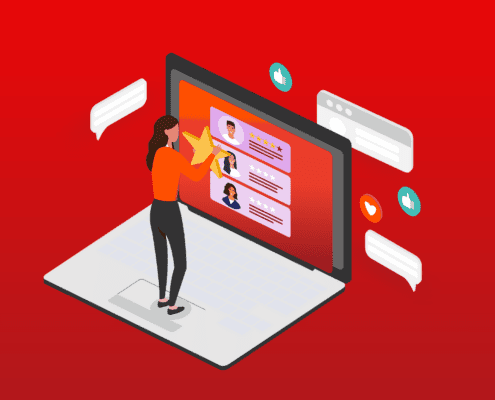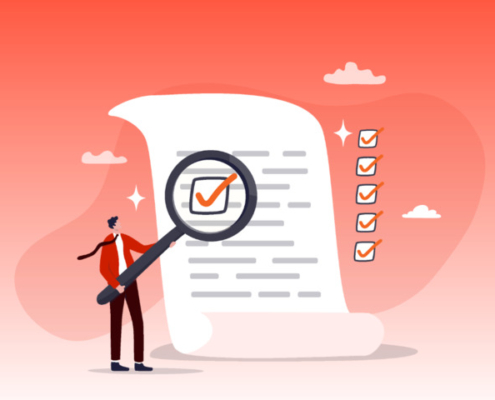

Picture this: you’ve got a list of leads in front of you, each one a potential goldmine waiting to be tapped. But in a world where everyone’s inbox is overflowing, and attention spans are shorter than ever, how do you cut through the noise and capture the attention of your prospects? How do you turn a lukewarm lead into a red-hot opportunity?
In this blog, we’ll dive deep into sales lead follow-up best practices. Here are the key points we’ll expand on:
- Personalize Communication to Each Lead
- Have a Clear Understanding of a Prospect’s Needs and Pain Points
- Continuously Nurture Quality Sales Leads
- Use More Than One Follow-up Strategy
- Utilize Your CRM to Streamline Follow-up Processes
- Prioritize Leads Based on Qualifications
- Be Consistent With the Follow-up Process
- Align Sales and Marketing Efforts
- Consistently Track and Measure Follow-up Performance
- Take Advantage of Value-Based Selling and Educating Prospects
- Be Clear and Concise With Your Calls to Action
- Follow-up in a Relevant, Timely Manner
- Implement Automation Tools Wisely
- Keep Training Your Sales Team on Follow-up Best Practices
Personalize Communication to Each Lead
Understanding the distinction between a generic message and a personalized one can be the difference between a lead that cools off and one that converts. Personalization shows that you value the prospective customer and have paid attention to their needs.
- Customize your email and call content: Use the lead’s name, refer to previous interactions, and make sure the message reflects their industry or specific interest.
- Analyze customer profiles: Delve into the lead’s interests, past purchases, and behavior to tailor your follow-up. This can mean suggesting products similar to past purchases or referencing a discussion from a previous call.
- Reference past interactions strategically: Reminding the lead of the last touchpoint can re-ignite their interest, but it’s crucial to do it tactfully and relevantly.
By personalizing your follow-up communications, you are not just reaching out; you are connecting. And a well-crafted, personalized follow-up can cement a relationship with a prospective customer that generic, one-size-fits-all messaging can never achieve.
Have a Clear Understanding of a Prospect’s Needs and Pain Points
To ensure that your lead follow-up strategy is effective, it’s critical to have a clear understanding of your prospect’s needs and pain points. Without this knowledge, your efforts may miss the mark, failing to resonate with the very people you’re trying to convert into customers. Tailoring your business service or product to each lead shows that you value their unique situation and are prepared to offer a solution that aligns with their specific challenges.
Thorough research before reaching out is not just beneficial; it’s a necessity. By understanding your prospect’s business, industry, and challenges, your follow-up can be more than just a pitch—it can be a conversation starter that positions your service as the answer to their needs.
Identifying and Addressing Customer Challenges
Sales teams should adhere to these tips to identify and address specific customer needs:
- Listen carefully to the prospect’s previous interactions with your company. This might give you insight into their expectations and concerns.
- Ask the right questions during initial conversations to draw out the pain points that your product or service can alleviate.
- Use social media and other online platforms to conduct preliminary research that might reveal pain points via the prospects’ comments or discussions.
- Analyze competitors to understand common industry challenges and how your offering can provide a unique solution.
- Adopt empathy in your communications – show that you genuinely understand and care about the problems they are facing.
Getting to the heart of what makes each prospect tick will not only lead to better conversion rates but will also foster stronger relationships and potentially turn one-time buyers into loyal customers.
Abstrakt’s outsourced cold callers are experts in understanding prospects and their needs, and building better relationships with decision-makers. We use cold calling as an outlet to connect and nurture relationships with prospects and set more quality B2B sales meetings. Learn about our approach to B2B appointment setting here.
Continuously Nurture Quality Sales Leads
Turning prospects into loyal customers is a marathon, not a sprint. Understanding that not all leads are ready to make a purchase immediately is crucial in shaping a robust lead follow-up strategy. Our approach should center on cultivating a positive, long-lasting relationship with each lead.
Here are some best practices to nurture your leads effectively over time:
- Provide periodic value: Stay in touch by sharing relevant content, such as blogs, whitepapers, or industry news, that can help leads address their challenges and goals.
- Segment your leads: Customize communication based on where the prospect is in the buyer journey, ensuring messages are relevant and timely.
- Use soft touches: A quick check-in email or a social media engagement can keep your brand top of mind without pressuring leads.
- Set a sensible frequency: Regular contact is key, but be careful not to overwhelm. Balance is vital; align your follow-up cadence with your product or service’s typical buying cycle.
- Gather feedback regularly: Understanding a lead’s changing needs and challenges over time can provide insights into how to better serve them.
- Be patient and persistent: Recognize that building trust takes time. Continue to nurture the relationship even when a lead is not actively engaging, as circumstances can change.
Remember that nurturing is about providing the lead with enough reason to choose you when they are ready. Patience and consistency in delivering value are the backbone of any effective lead follow-up strategy.
Use More Than One Follow-up Strategy
Embracing a multi-channel communication strategy is crucial for effective lead follow-up in today’s dynamic market. Potential clients are all over the map, quite literally, and they engage through various platforms. This diversity necessitates a broad-reaching approach that taps into the power of multiple touchpoints.
Incorporating various communication methods – such as emails, phone calls, and social media interactions – ensures you meet prospects where they are most comfortable. The benefits of this approach include:
- Increased reach: You capture the attention of leads across different platforms, enhancing the visibility of your message.
- Customer preference: Some leads prefer a quick text or social media message, while others might appreciate a more personal touch like a phone call.
- Better engagement: Multi-channel strategies can lead to higher engagement rates, as you use the preferred channels of communication for your audience.
- Resilience to platform changes: Diversifying your channels protects against changes or issues with any single communication platform.
While it’s essential to communicate across different platforms, it’s equally important to maintain a consistent brand experience. Every interaction, regardless of channel, should reflect your company’s values and messaging, creating a cohesive journey for the lead. Any disconnect can create confusion and reduce the effectiveness of your follow-up efforts.
A well-orchestrated multi-channel approach is integral to sales lead follow-up best practices. It aligns with the modern customer’s expectation for a personalized, consistent, and engaging experience with your brand across all platforms.
Learn More: What to Know About Multi-Channel Lead Generation

Utilize Your CRM to Streamline Follow-up Processes
Efficiently managing and nurturing sales leads is crucial for any successful business strategy. A robust Customer Relationship Management (CRM) system is at the heart of this process, allowing for seamless follow-up with prospective clients.
Streamlining Follow-Up Processes with a CRM
One of the key advantages of using a CRM is its ability to simplify the follow-up process with the integration of marketing automation tools. By automating tasks such as scheduling calls or sending reminder emails, a CRM ensures that no lead is forgotten, and every potential customer receives timely and appropriate attention. This functional prowess of CRMs helps in maintaining a high level of organization that is often challenging to achieve manually.
Tracking Sales Leads and Managing Customer Information
Organization and accessibility of information are essential for efficient service delivery. CRMs excel in this domain by providing a centralized platform to track sales leads and store critical customer data. Sales teams can quickly access a prospect’s history, preferences, and previous interactions, enabling them to tailor their service effectively. With a CRM, every detail is at your team’s fingertips, paving the way for more informed and responsive customer engagement.
- A CRM helps in pinpointing where each prospect is in the sales funnel, making lead prioritization more straightforward.
- It ensures that all customer interactions are logged, which is critical in understanding the context of each follow-up.
- Advanced CRMs with analytics can provide actionable insights to further refine the follow-up strategy.
By embracing best practices in CRM utilization, your business can deliver efficient, personalized service that meets the high expectations of modern consumers.
Learn More: CRM vs. Lead Management Software
Prioritize Leads Based on Qualifications
Understanding lead qualification and prioritization is crucial to finessing the art of lead follow-up. Implementing strategic methods to assess and sequence leads can make your follow-up process not just effective but highly efficient.
Begin by establishing clear criteria to measure lead quality. These criteria might include:
- The lead’s budget and authority
- Urgency and timeline for the potential project
- Alignment with your product or service offerings
- Past interactions and engagement with your brand
- Specific needs or challenges they’re looking to address with your solution
After qualifying leads, the next step involves prioritizing them based on their potential for conversion and impact on revenue. Not all leads hold equal value, so allocating resources efficiently demands a systematic approach. Implementing a lead scoring system helps assign numerical values to leads, reflecting their qualification criteria. Coordination with the marketing department is essential here to ensure the lead passes certain qualities before moving forward. Priority should be given to leads exhibiting higher levels of engagement, such as repeated website visits or email interactions.
Additionally, leads with the potential for larger deal sizes should be emphasized due to their significant revenue impact. Understanding the lead’s stage in the buying process is crucial; prioritizing those in the decision-making phase over those still gathering information ensures resource optimization.
Be Consistent With the Follow-up Process
Having a consistent and structured follow-up process is not just best practice; it’s essential to turning potential leads into loyal customers. Establishing a systematic framework allows you to nurture your leads effectively, ensuring that no prospect slips through the cracks.
Implementing a step-by-step follow-up strategy prevents oversight and increases conversion rates. Key components of this framework include:
- Defining clear follow-up timelines for each stage of the lead lifecycle.
- Setting up standardized communication templates that can be personalized easily.
- Automating certain follow-up tasks to maintain consistency, without sacrificing the personal touch.
- Utilizing reminders and alerts to prompt timely engagement.
Align Sales and Marketing Efforts
In the realm of effective lead follow-up, the synergy between sales and marketing teams is not merely beneficial; it’s imperative. As the bridge between initial interest and final conversion narrows, a smoothly coordinated effort can significantly amplify success rates.
Best Practices for Sales and Marketing Teamwork
- Establish Shared Goals: Begin by setting mutual objectives that resonate with both Sales and Marketing. Aligning on commonly agreed KPIs and revenue targets fosters a sense of shared purpose and accountability.
- Open Communication Channels: Regular meetings and updates between teams create an environment of transparency and openness. Utilize tools that facilitate real-time communication and ensure that vital lead information is accessible to all relevant parties.
- Develop Joint Lead Scoring Criteria: Collaboratively define what makes a lead ‘qualified’ by combining insights from both sales patterns and marketing engagement metrics. This unified approach will help prioritize follow-up efforts where they’re most likely to convert.
- Map Out a Unified Lead Nurturing Strategy: Employ a comprehensive strategy that considers content marketing efforts and sales engagement activities. Establish a clear path for leads at each stage of the funnel and determine appropriate actions for both teams.
- Create Service Level Agreements (SLAs): Draft clear SLAs between Sales and Marketing to set expectations for lead handling, follow-up timings, and the hand-off process. This formalizes the collaboration and encourages adherence to best practices.
- Regular Performance Review: Periodic review of joint efforts and outcomes is crucial for continuous improvement. Share successes, challenges, and learnings to fine-tune strategies and strengthen the Sales and Marketing bond over time.
Paving the way for a seamless lead follow-up procedure demands a partnership between Sales and Marketing built on communication, aligned objectives, and reciprocal support. By implementing these best practices, businesses can transform their lead follow-up process into a well-oiled machine that consistently nurtures and converts prospects into loyal customers.
Learn More: Best Practices to Sales and Marketing Alignment
Consistently Track and Measure Follow-up Performance
Understanding the performance of your lead follow-up strategies is crucial to refining your approach and maximizing conversion rates. But what metrics should you be tracking to gain these insights?
Here are some essential metrics to monitor:
- Follow-Up Frequency: How often are you reaching out to leads? Tracking this helps ensure you’re not under or over-communicating.
- Lead Response Time: The speed at which you respond to leads can make or break a sale. Monitor this to aim for prompt replies.
- Conversion Rate: Ultimately, the success of your follow-ups is measured by the percentage of leads that turn into customers.
The Power of Analytics in Follow-Up Refinement
Analyzing your follow-up metrics is not just about collecting data—it’s about driving actionable insights. By examining these numbers, you’re able to:
- Identify patterns that lead to higher conversion rates.
- Adjust your follow-up strategies to engage leads more effectively.
- Optimize the allocation of your resources to focus on the most promising leads.
- Improve alignment between sales and marketing efforts for a coherent strategy.
Embrace analytics as your guide. By tracking and analyzing follow-up metrics, you’ll enhance your ability to connect with prospects meaningfully and boost your overall sales performance.
Take Advantage of Value-Based Selling and Educating Prospects
Value-based selling is a crucial element of effective lead follow-up. Instead of focusing solely on making a sale, it’s about guiding your prospects through a journey of understanding the unique benefits and real-world applications of your offerings.
Building Trust Through Education
Educating your leads isn’t just about imparting knowledge; it’s a strategic move to build trust and credibility. When prospects see that you’re invested in helping them understand how your service or product fits into their individual context, they are more likely to view your brand as a partner rather than just a vendor. This educational approach sets the foundation for long-term customer relationships because you’re viewed as a valuable resource, not just a supplier.
Value Trumps Volume—Every Time
By adopting value-based selling and education in your lead follow-up practices, you also distinguish your communication from the competition. Prospects often receive numerous sales pitches and follow-ups, but those that provide substantive value stand out. Through personalized, educational content, you demonstrate a deep understanding of your prospect’s needs and challenges, fostering a relationship where the lead is excited to learn more rather than feeling pressured to purchase.
Long-term benefits of value-based selling include:
- Establishes your business as an industry authority.
- Promotes customer engagement by providing relevant, useful information.
- Leads to higher conversion rates as prospects recognize the unique worth of your offerings.
- Encourages customer loyalty and referrals due to positive educational experiences.
Be Clear and Concise With Your Calls to Action
A well-crafted call to action (CTA) can command attention and incite action, the difference between a lead that fizzles out and a fruitful customer relationship. It’s the linchpin of every successful follow-up communication, transforming passive readers into active participants.
To maximize conversion opportunities, it’s essential to ensure your CTAs are as clear and compelling as possible. An effective CTA goes beyond mere words; it’s a strategic beacon guiding your leads toward the next essential step in their customer journey.
Here are some best practices for CTA creation:
- Clarity is Key: A vague or confusing CTA can detract from your lead’s experience. Use unmistakable language that leaves no room for uncertainty about what action they should take next.
- Stimulate Engagement: Your CTA should resonate with the lead’s wants and needs, offering a solution that feels both relevant and beneficial. Make it about the value they can gain by taking action.
- Visual Distinction: Design your CTAs to stand out with contrasting colors or bold buttons. Eye-catching elements can significantly increase click-through rates.
- Urgency and Exclusivity: Phrases like “limited time offer” or “exclusive access” can create a sense of immediacy or exclusivity, encouraging quicker responses.
- Accessibility: Ensure that CTAs are easy to find and click across all devices, catering to the growing number of mobile users.
Embracing these guidelines equips you with the power to transform your lead follow-up strategy into an irresistible invitation for engagement. Remember, the CTA is not just a button or a line of text; it is a critical step on the pathway to conversion. Use it wisely, and watch your leads leap into action.
Follow-up in a Relevant, Timely Manner
Striking the right balance with your follow-up cadence and timing can mean the difference between nurturing a lead toward a sale and pushing it away. To harness the full potential of lead follow-up, you need to implement best practices that resonate with your prospects while respecting their time and boundaries.
Follow-up strategies should be informed by industry standards, consumer behavior, and the unique insights you have about your prospects. A classic strategy is to respond within an hour of a query, as promptness can significantly increase the likelihood of converting a lead.
Once initial contact has been made, spacing follow-ups using structured timing sequences, such as 1-2 days after the first interaction, then weekly, can maintain engagement without overwhelming the lead.
Balancing Persistence with Perceptiveness
Persistence is key in lead follow-up, but it’s equally crucial to avoid being perceived as spammy. Pay close attention to the lead’s signals — if they seem unresponsive or have asked for more time, it’s important to respect their wishes. Use their feedback to tailor your follow-up strategy, always prioritizing their comfort and readiness to proceed.
- Respect Boundaries: Always obtain permission to follow up and honor any requests to postpone or cease communication.
- Read the Signs: Pay attention to signals from your leads, such as engagement levels and response times, to gauge their interest and adjust your approach accordingly.
- Value-Driven Communication: Ensure that each follow-up provides value, whether that’s sharing relevant information, answering questions, or offering solutions to their problems.
Adopting these strategies to determine the optimal timing and frequency of your follow-ups can significantly improve your lead conversion rates. Emphasize the balance between persistent follow-up and respectful communication to forge trust and foster positive relationships with potential clients.
Implement Automation Tools Wisely
Adopting automation tools in your lead follow-up strategy can significantly improve your efficiency and effectiveness. However, it’s important to understand the balance between automation and human touch to maintain genuine connections with your prospects.
Automation tools can provide numerous advantages when it comes to following up on leads. They enable teams to:
- Ensure prompt response times, which can make the difference between winning or losing a potential customer.
- Deliver personalized communication at scale with the use of dynamic content tailored to each lead’s interactions and behaviors.
- Maintain a consistent follow-up process, sending reminders and communications without the risk of human error or forgetfulness.
Avoid these Automation Pitfalls
There are potential downsides to consider when incorporating automation:
- Lack of personalization: Over-reliance on automation can result in generic communications that fail to resonate with the recipient.
- Over-automating the process: Losing the human element in your follow-up can make your brand seem cold and uncaring.
- Ignoring context: Automation tools might not always grasp the nuances of a lead’s situation, which can lead to inappropriate or untimely messages.
- Obvious AI-generated copy:
Best Automation Tools for Sales Lead Follow-up
Choosing the right automation tools is crucial. Here are a few reputable options that can bolster your lead follow-up systems:
- HubSpot: Offers a full stack of tools for marketing, sales, and customer service, with a completely free CRM at its core.
- Marketo: Known for its engagement platform that helps personalize and automate various marketing tasks.
- Salesforce Pardot: A powerful marketing automation solution that works seamlessly with the Salesforce CRM, enabling sales and marketing alignment.
Incorporating automation tools into your lead follow-up strategy can significantly enhance efficiency and effectiveness, but finding the right balance between automation and personal connection is crucial. Automation offers several benefits, including ensuring prompt responses, delivering personalized communication at scale, and maintaining a consistent follow-up process.
However, potential pitfalls to be aware of include a lack of personalization, over-automation, and overlooking contextual nuances. Selecting the appropriate automation tools is essential, and they can greatly improve your lead follow-up systems by providing robust features and integration capabilities.
Keep Training Your Sales Team on Follow-up Best Practices
To maintain effectiveness in lead follow-up, it is crucial to acknowledge that the learning process never truly ends. As the market transforms and new communication methods emerge, sales teams must continuously evolve to be successful. This section highlights why ongoing training and developmental strategies are non-negotiable for any sales team committed to excellence in lead follow-up.
As the sales landscape shifts, so should the strategies employed by sales teams. Ongoing training ensures that sales representatives are not only up-to-date with the latest best practices but also adept at utilizing new tools and technologies that emerge. This arms them with the knowledge and skills necessary to communicate effectively with leads, enhancing the overall sales process.
Fostering a Culture of Continuous Improvement
To stay ahead in today’s competitive marketplace, embracing a culture of continuous improvement is imperative. Regular training sessions, workshops, and seminars can create an environment that promotes shared learning and open conversations about what strategies are working and what can be improved. Encouraging adaptability empowers teams to refine their follow-up strategies as business and customer needs evolve, fostering innovation and a proactive approach to sales challenges.
- Assessment of current strategies and their outcomes to identify areas for growth.
- Engagement in skill-building and educational programs to enhance sales techniques.
- Incorporation of feedback loops between sales reps and managers to optimize follow-up approaches.
For sales teams to succeed with lead follow-ups, they must be committed to continual learning and skill enhancement. Continuous training and improvement are the hallmarks of a resilient and successful sales operation that can confidently adjust to the marketplace’s ever-changing demands.
Key Takeaways
It’s clear that efficient sales lead follow-up strategies are more than just a task on your sales team’s to-do list—they’re the foundational pillars that hold up your entire sales process. By integrating prompt responses, personalized communication, multi-channel approaches, and other best practices, you are setting your business up for noticeable growth and significant improvements in customer satisfaction.
The direct benefits of a well-crafted follow-up strategy cannot be overstated. Whether it’s understanding the prospect’s unique needs, effectively using your CRM, or ensuring that sales and marketing work in tandem, these practices lead to better lead conversion rates and business development outcomes. By nurturing leads over time, prioritizing continuously, and leveraging automation tools judiciously, your B2B company can experience meaningful gains in both efficiency and profitability.
Abstrakt Marketing Group is a nationally recognized B2B lead generation company that empowers growing businesses like yours to find qualified prospects and nurture relationships with decision-makers before they’re ready to buy. From cold calling to SEO lead generation, we have a process in place that effectively introduces prospects in the sales pipeline and pushes them down the sales funnel.
When you’re ready to maximize your ability to generate and follow up with quality sales leads, contact the growth experts at Abstrakt!




